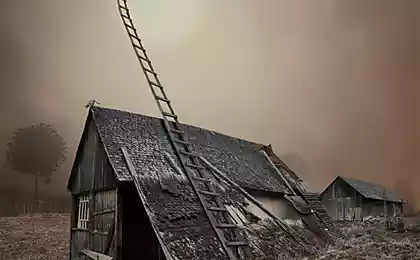259
Peter Levine: 8 Practical Steps to Healing Injuries
Healing from trauma: practical steps
Psychologist Peter Levine in his book “Healing from trauma” writes that society teaches us to deal with experiences, hide them, “be strong”, “not to give up in the face of difficulties” – we watch films about strong personalities who always overcome any obstacles, read books in which the characters “take themselves together” and go on, against all odds. We are taught to “hold our face”, not to pretend that we are hurt, not to allow ourselves to be weak, although, Levin writes, Psychological trauma is carried no easier, or even much harder physical.
474363
Imagine that a person who broke a leg a week ago goes to play football - with a high probability he will be considered a complete idiot. At the same time, when a girl who is experiencing a severe break with her beloved, “pulls herself together” and behaves as if nothing happened (or even immediately rushes into a new relationship, from which, most likely, she will come out even more traumatized), we admire the strength of her spirit.
The difficulty is that psychological trauma is a very subjective concept. If the consequences of physical trauma are obvious and can be easily treated, each of us has to deal with psychological trauma on our own. It is impossible to avoid traumatic experiences, Levin himself writes about the fundamental role that trauma plays in our lives: severe trials help us to realize important things for us, to transform. But it is very important to go through and complete all the processes correctly, so that the traumatic experience becomes an experience on which we can rely, and not a source of problems and diseases.
Peter Levine developed a program for proper treatment of trauma, the basics of which he outlined in his book Healing from Injuries.Levin’s approach is interesting: he works with the sensations of the body, and through them helps a person get rid of the destructive energy of trauma.
Its program consists of 8 main stages:
Phase 1: Returning the Sense of SafetyIf you have experienced a traumatic event (betrayal of a loved one, death of a loved one, public humiliation, breakup of relationships, etc.), then the first thing the doctor advises to start with is to restore the boundaries of your own space. The traumatic event destroys our defenses, we no longer feel safe, we are literally torn apart by heavy emotions, we feel unprotected against external aggression.
Levine offers special exercises to help us feel the boundaries within which we are safe: the boundaries of our bodies.Knocking on the skin, a contrast shower will help literally “skin” to feel the border that separates and protects our personal space from the aggressive outside world. Feel that you are "in the house" and no one and nothing can enter your space, you are absolutely safe.
Phase 2: Finding the Soil Under the FeetAny traumatic event literally knocks the ground out from under our feet. It seems to us that everything is collapsing around us, everything is unstable: we seem to be flying at speed in an airless space, and there is nothing we can do about it, we do not control events that develop against our will. Levine recommends "grounding" - literally stand with your bare feet on the ground and just feel that here it is, the soil, that you stand very securely. There is no airless space, you stand on the ground with two legs, and the world does not collapse around you, everything is stable. You don’t fall or lose your balance, you’re 100% in control, feel it and give yourself time to feel it.
Phase 3: Identification of “Support” sources And "Breaches"This is a very important stage. Everyone has their own ways of replenishing energy – someone sleeps or rereads their favorite books to recover, someone cooks and eats their favorite food, someone plays sports, someone listens to music, someone goes to his mother, and so on. Levine advises trying to identify what is such a source for you—remember what helped you overcome traumatic experiences in the past? What activities bring you satisfaction, soothing? What kind of people do you feel safe with, who feeds you with their energy?
Levine advises you to close your eyes and imagine possible sources of energy, as well as try to see who or what is taking away your energy. The gaps through which energy is drained can be, for example, parents who demand that we meet their requirements, or someone near us who sucks up energy and time, unloved work, unpleasant routines, or even certain places, cities and countries.
After you have made a register of “power sources” and identified “gaps”, it is important to protect yourself as much as possible from what takes energy, andFill your life with activities and communication with those people who charge you. When you recover from a physical injury, you follow a certain regimen and avoid things that can make your condition worse – recovery from a mental injury follows the same principle. You are now very vulnerable, protect yourself to the maximum from new injuries.
Phase 4: Tracking the Injury EffectAt this stage, the psychologist teaches you to monitor the sensations of the body to understand how the traumatic experience is projected onto the physical sensations. For example, when a girl experiences the pain of betrayal, where does that emotion manifest physically? How does it feel physically? Pain in the solar plexus? Cold in the stomach? Who's in the throat? It is important to track these sensations and try to “feel” – what is the size of this lump? By weight? What material is it made of?
Stage 5: Active observation of feelingsOnce you can track the physical manifestations of your experiences, the traumatic effect of the event will begin to decline because you will feel in control again. It is impossible to stop feeling resentment or fear, but it is possible to observe and control the physical sensations that trigger these emotions.
At this stage, the doctor advises to carefully observe yourself and body sensations. Close your eyes and ask yourself: How do I feel when I remember the event? What sensations in the body do I feel when I think of a person with whom a traumatic experience is associated? Are those feelings changing? Perhaps the stone you feel in the solar plexus when you think about betraying your loved one becomes lighter and less dense? Or vice versa? Perhaps the lump in your throat that you feel when you remember the death of a loved one has gone, and instead you feel chest pain?
Observe and record your feelings.
Phase 6: “Contact with Survival”Severe traumatic experiences often have a long-term negative impact because it is too difficult for us to return to them to process them into experiences and let them go. The energy that is released in the moment of trauma (shame, fear, humiliation – these are all very powerful experiences that release a lot of energy) does not go away, and if we do not release it, it remains inside a time bomb.
"Contact with experience" is an opportunity to demine this bomb. In his book, the psychologist cites several exercises that help to “neutralize” the trauma, all of them are based on playing different scenarios of the moment of the traumatic experience and observing oneself. As one of the exercises, Levin advises you to sit in a comfortable position, close your eyes, return to the moment of experience, remember your feelings (shame, fear, pain, horror, etc.) and try to keep your attention on these feelings for as long as possible, until they begin to change and their intensity begins to decrease.

Stage 7: Return to normal lifeWhen we are in the grip of trauma, we are so preoccupied with our pain and survival that we hardly respond to external experiences. We don’t feel the taste of food, we don’t notice the good weather, all our sensations are dulled. After unleashing a devastating hurricane, we may finally open our eyes and be surprised to discover a world we didn’t notice while being treated for trauma.
Levin literally advises you to open your eyes and carefully examine the objects around you: their color, features, purpose. What's going on in the world? What films, books, topics are discussed? Curiosity, which is awakened at this stage, helps to finally get rid of the consequences of trauma - trauma can not coexist with the energy of knowledge that drives us forward.
Phase 8: Consolidating the Results and Moving OnWhen the severity of the traumatic experience is gone, you will feel the strength and desire to move forward. It is very important to stay on this wave without sliding back and sometimes outside help may be needed. Levin cites an affirmation, which he advises all his clients to repeat, which is actually an ancient North American Indian prayer: “I am grateful for the help that I know is on its way to me.”
When the traumatic experience is worked through and we are freed from the yoke of destructive emotions, a new energy fills our sails. We sincerely thank fate for the experience, albeit very difficult, and take a step into a happy future.published
Author: Peter Levin, posted by Lyudmila Kolobovskaya
P.S. And remember, just by changing your consciousness – together we change the world!
Source: //www.b17.ru/blog/31897/
Psychologist Peter Levine in his book “Healing from trauma” writes that society teaches us to deal with experiences, hide them, “be strong”, “not to give up in the face of difficulties” – we watch films about strong personalities who always overcome any obstacles, read books in which the characters “take themselves together” and go on, against all odds. We are taught to “hold our face”, not to pretend that we are hurt, not to allow ourselves to be weak, although, Levin writes, Psychological trauma is carried no easier, or even much harder physical.
474363
Imagine that a person who broke a leg a week ago goes to play football - with a high probability he will be considered a complete idiot. At the same time, when a girl who is experiencing a severe break with her beloved, “pulls herself together” and behaves as if nothing happened (or even immediately rushes into a new relationship, from which, most likely, she will come out even more traumatized), we admire the strength of her spirit.
The difficulty is that psychological trauma is a very subjective concept. If the consequences of physical trauma are obvious and can be easily treated, each of us has to deal with psychological trauma on our own. It is impossible to avoid traumatic experiences, Levin himself writes about the fundamental role that trauma plays in our lives: severe trials help us to realize important things for us, to transform. But it is very important to go through and complete all the processes correctly, so that the traumatic experience becomes an experience on which we can rely, and not a source of problems and diseases.
Peter Levine developed a program for proper treatment of trauma, the basics of which he outlined in his book Healing from Injuries.Levin’s approach is interesting: he works with the sensations of the body, and through them helps a person get rid of the destructive energy of trauma.
Its program consists of 8 main stages:
Phase 1: Returning the Sense of SafetyIf you have experienced a traumatic event (betrayal of a loved one, death of a loved one, public humiliation, breakup of relationships, etc.), then the first thing the doctor advises to start with is to restore the boundaries of your own space. The traumatic event destroys our defenses, we no longer feel safe, we are literally torn apart by heavy emotions, we feel unprotected against external aggression.
Levine offers special exercises to help us feel the boundaries within which we are safe: the boundaries of our bodies.Knocking on the skin, a contrast shower will help literally “skin” to feel the border that separates and protects our personal space from the aggressive outside world. Feel that you are "in the house" and no one and nothing can enter your space, you are absolutely safe.
Phase 2: Finding the Soil Under the FeetAny traumatic event literally knocks the ground out from under our feet. It seems to us that everything is collapsing around us, everything is unstable: we seem to be flying at speed in an airless space, and there is nothing we can do about it, we do not control events that develop against our will. Levine recommends "grounding" - literally stand with your bare feet on the ground and just feel that here it is, the soil, that you stand very securely. There is no airless space, you stand on the ground with two legs, and the world does not collapse around you, everything is stable. You don’t fall or lose your balance, you’re 100% in control, feel it and give yourself time to feel it.
Phase 3: Identification of “Support” sources And "Breaches"This is a very important stage. Everyone has their own ways of replenishing energy – someone sleeps or rereads their favorite books to recover, someone cooks and eats their favorite food, someone plays sports, someone listens to music, someone goes to his mother, and so on. Levine advises trying to identify what is such a source for you—remember what helped you overcome traumatic experiences in the past? What activities bring you satisfaction, soothing? What kind of people do you feel safe with, who feeds you with their energy?
Levine advises you to close your eyes and imagine possible sources of energy, as well as try to see who or what is taking away your energy. The gaps through which energy is drained can be, for example, parents who demand that we meet their requirements, or someone near us who sucks up energy and time, unloved work, unpleasant routines, or even certain places, cities and countries.
After you have made a register of “power sources” and identified “gaps”, it is important to protect yourself as much as possible from what takes energy, andFill your life with activities and communication with those people who charge you. When you recover from a physical injury, you follow a certain regimen and avoid things that can make your condition worse – recovery from a mental injury follows the same principle. You are now very vulnerable, protect yourself to the maximum from new injuries.
Phase 4: Tracking the Injury EffectAt this stage, the psychologist teaches you to monitor the sensations of the body to understand how the traumatic experience is projected onto the physical sensations. For example, when a girl experiences the pain of betrayal, where does that emotion manifest physically? How does it feel physically? Pain in the solar plexus? Cold in the stomach? Who's in the throat? It is important to track these sensations and try to “feel” – what is the size of this lump? By weight? What material is it made of?
Stage 5: Active observation of feelingsOnce you can track the physical manifestations of your experiences, the traumatic effect of the event will begin to decline because you will feel in control again. It is impossible to stop feeling resentment or fear, but it is possible to observe and control the physical sensations that trigger these emotions.
At this stage, the doctor advises to carefully observe yourself and body sensations. Close your eyes and ask yourself: How do I feel when I remember the event? What sensations in the body do I feel when I think of a person with whom a traumatic experience is associated? Are those feelings changing? Perhaps the stone you feel in the solar plexus when you think about betraying your loved one becomes lighter and less dense? Or vice versa? Perhaps the lump in your throat that you feel when you remember the death of a loved one has gone, and instead you feel chest pain?
Observe and record your feelings.
Phase 6: “Contact with Survival”Severe traumatic experiences often have a long-term negative impact because it is too difficult for us to return to them to process them into experiences and let them go. The energy that is released in the moment of trauma (shame, fear, humiliation – these are all very powerful experiences that release a lot of energy) does not go away, and if we do not release it, it remains inside a time bomb.
"Contact with experience" is an opportunity to demine this bomb. In his book, the psychologist cites several exercises that help to “neutralize” the trauma, all of them are based on playing different scenarios of the moment of the traumatic experience and observing oneself. As one of the exercises, Levin advises you to sit in a comfortable position, close your eyes, return to the moment of experience, remember your feelings (shame, fear, pain, horror, etc.) and try to keep your attention on these feelings for as long as possible, until they begin to change and their intensity begins to decrease.

Stage 7: Return to normal lifeWhen we are in the grip of trauma, we are so preoccupied with our pain and survival that we hardly respond to external experiences. We don’t feel the taste of food, we don’t notice the good weather, all our sensations are dulled. After unleashing a devastating hurricane, we may finally open our eyes and be surprised to discover a world we didn’t notice while being treated for trauma.
Levin literally advises you to open your eyes and carefully examine the objects around you: their color, features, purpose. What's going on in the world? What films, books, topics are discussed? Curiosity, which is awakened at this stage, helps to finally get rid of the consequences of trauma - trauma can not coexist with the energy of knowledge that drives us forward.
Phase 8: Consolidating the Results and Moving OnWhen the severity of the traumatic experience is gone, you will feel the strength and desire to move forward. It is very important to stay on this wave without sliding back and sometimes outside help may be needed. Levin cites an affirmation, which he advises all his clients to repeat, which is actually an ancient North American Indian prayer: “I am grateful for the help that I know is on its way to me.”
When the traumatic experience is worked through and we are freed from the yoke of destructive emotions, a new energy fills our sails. We sincerely thank fate for the experience, albeit very difficult, and take a step into a happy future.published
Author: Peter Levin, posted by Lyudmila Kolobovskaya
P.S. And remember, just by changing your consciousness – together we change the world!
Source: //www.b17.ru/blog/31897/























